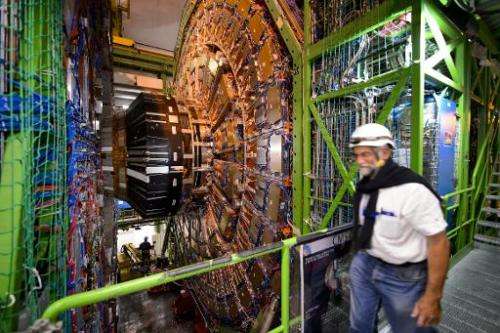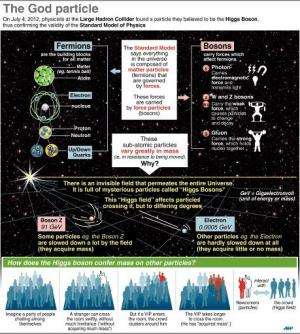Higgs quest deepens into realm of 'New Physics'

Two years after making history by unearthing the Higgs boson, the particle that confers mass, physicists are broadening their probe into its identity, hoping this will also solve other great cosmic mysteries.
Sifting through mountains of experimental data, they have now pieced together a partial sketch of the evasive boson's traits and behaviour.
But, some of them admit to be puzzled.
The better they become acquainted with the Higgs at the infinitely small quantum level, the further the experts seem from explaining certain cosmic-scale questions, like dark matter.
"The observed characteristics of the Higgs boson, such as its mass, interaction strengths and life-time, provide very powerful constraints on our understanding of the more fundamental theory," Valya Khoze, director of the Institute for Particle Physics Phenomenology (IPPP) at Durham University, told AFP.
From next year, scientists will smash sub-atomic particles at ever higher-speeds in the upgraded Large Hadron Collider (LHC) near Geneva, which announced the Higgs discovery on July 4, 2012.
Not only will they hope for new particles to emerge, but also for the Higgs to show signs of, well, weirdness.
So far, the Higgs has conformed well to the traits predicted in the Standard Model of particle physics, the mainstream theory of how our Universe is constructed.
Too well, for some.
The model has weaknesses in that it doesn't explain dark matter or dark energy, which jointly make up 95 percent of the Universe. Nor is it compatible with the theory of gravity.
Scientists have proposed alternative theories to explain the inconsistencies—like supersymmetry which postulates the existence of a "sibling" for every particle in the Universe and may explain dark matter and dark energy.

No proof of such symmetric particles has been found at the LHC, currently in sleep mode for an 18-month overhaul to super-boost its power levels.
Supersymmetry, additionally, predicts the existence of at least five types of Higgs boson, and physicists will thus be watching the LHC Higgs closely for signs of behaviour inconsistent with the Standard Model.
'New Physics'
"It would give us a very good hint that there is physics there beyond the Standard Model and that there's new, additional physics coming soon," said Dave Charlton, who heads the ATLAS experiment at the LHC.
"It could help to explain many of the other problems we have in physics at the moment."
The LHC is a facility of the European Organisation for Nuclear Research (CERN) which celebrated its 60th anniversary on Tuesday.
The Higgs boson is a cornerstone of the Standard Model, a theory developed in the early 1970s to explain the five percent of the Universe composed of visible matter and energy, all carried by fundamental particles.
But some of the boson's newly discovered properties have left physicists scratching their heads.
For starters, they don't understand how it can have such a small mass.
Nor is the evidence consistent for the role it played in the development of the early Universe after the Big Bang—issues that may be resolved by so-called New Physics the experts hope will follow soon.
When the LHC fires up again next year, scientists will be on the lookout for new particles, including other types of Higgs, and possible "invisible decays" of the boson to indicate the presence of dark matter.
"All of the particles of the Standard Model have now been discovered," said Charlton.
"If we see new particles, it's something new... if we see new particles, it will point to something whether it is supersymmetry or some other new theory.
"It will tell us that the Standard Model is broken, that there is something else."
Charlton said we may never know if the Higgs found at the LHC was exactly the Standard Model version or something that just resembles it.
Themis Bowcock, particle physics head at the University of Liverpool, said confirmation of several Standard Model predictions over the past two years have placed a new focus on what is not yet known.
"It allows us to step back and view the boundaries of our knowledge with a keener eye," he told AFP.
"We realise we have mastered our closest and most obvious challenges, but like a 15th century navigator we are motivated to venture beyond our mapped lands to discover the missing 95 percent—the New World."
© 2014 AFP




















